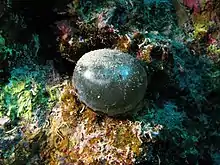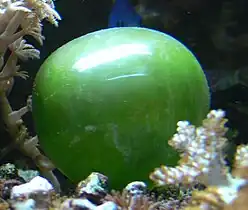Valonia ventricosa
Valonia ventricosa, also known as bubble algae, sea grape,[2] or sailor's eyeballs,[3] is a species of algae found in oceans throughout the world in tropical and subtropical regions, within the phylum Chlorophyta. It is one of the largest known unicellular organisms.[3][4]

| Valonia ventricosa | |
|---|---|
 | |
| Scientific classification | |
| (unranked): | Viridiplantae |
| Division: | Chlorophyta |
| Class: | Ulvophyceae |
| Order: | Cladophorales |
| Family: | Valoniaceae |
| Genus: | Valonia |
| Species: | V. ventricosa |
| Binomial name | |
| Valonia ventricosa | |
| Synonyms | |
|
Ventricaria ventricosa | |
Characteristics
Valonia ventricosa has a coenocytic structure with multiple nuclei and chloroplasts.[5] This organism possesses a large central vacuole that is multilobular in structure (lobules radiating from a central spheroid region).
The entire cell contains several cytoplasmic domains, with each domain having a nucleus and a few chloroplasts.[5] Cytoplasmic domains are interconnected by cytoplasmic "bridges" that are supported by microtubules.[5] The peripheral cytoplasm (whose membrane is overlaid by the cell wall) is only about 40 nm thick.[5]
Valonia ventricosa typically grow individually, but in rare cases they can grow in groups.
Environment
They appear in tidal zones of tropical and subtropical areas, like the Caribbean, north through Florida, south to Brazil, and in the Indo-Pacific.[3] Overall, they inhabit every ocean throughout the world,[6] often living in coral rubble.[7] The greatest observed depth for viability is approximately 80 metres (260 ft).
Physiology and reproduction
The single-cell organism has forms ranging from spherical to ovoid, and the color varies from grass green to dark green, although in water they may appear to be silver, teal, or even blackish.[3] This is determined by the quantity of chloroplasts of the specimen.[7] The surface of the cell shines like glass when clean due to being extremely smooth with no texture.
Valonia ventricosa is among the largest known single-celled organisms. Its thallus consists of a thin-walled, tough, multinucleate cell with a diameter that ranges typically from 1 to 4 centimetres (0.4 to 1.6 in), although it may achieve a diameter of up to 5.1 centimetres (2.0 in) in rarer cases. The "bubble" alga is attached by rhizoids to the substrate fibers.[3]
Reproduction occurs by segregative cell division, where the multinucleate parent cell makes child cells, and individual rhizoids form new bubbles, which become separate from the parent cell.
Studies
Valonia ventricosa has been studied particularly because the cells are so unusually large that they provide a convenient subject for studying the transfer of water and water-soluble molecules across biological membranes. It was concluded that the properties of permeability in both osmosis and diffusion were identical, and that urea and formaldehyde molecules did not require any kind of postulated water-filled pores in the membrane to move through it.[3][8][9] In studying the cellulose lattice and its orientation in biological structures, Valonia ventricosa has undergone extensive X-ray analytical procedures.[10] It has also been studied for its electrical properties due to its unusually high electrical potential relative to the seawater that surrounds it.[8]
In aquaria
Valonia ventricosa is considered a pest by some aquarium owners, as it can reproduce quickly and potentially endanger the health of fish or other organisms.[11][12]
See also
References
- "Valonia ventricosa J. Agardh". ITIS. Retrieved 27 August 2010.
- Spangler, Randall. "Sea Grape (Valonia ventricosa) - Spanglers' Scuba". scuba.spanglers.com. Retrieved 2022-06-05.
- Bauer, Becky (October 2008). "Gazing Balls in the Sea". All at Sea. Retrieved 26 September 2013.
- Tunnell, John Wesley; Chávez, Ernesto A.; Withers, Kim (2007). Coral reefs of the southern Gulf of Mexico. Texas A&M University Press. p. 91. ISBN 978-1-58544-617-9.
- Shepherd, VA; Beilby, MJ; Bisson, MA (June 2004). "When is a cell not a cell? A theory relating coenocytic structure to the unusual electrophysiology of Ventricaria ventricosa (Valonia ventricosa)" (PDF). Protoplasma. 223 (2–4): 79–91. doi:10.1007/s00709-003-0032-4. ISSN 0033-183X. PMID 15221513. S2CID 13373143.
- "Valonia ventricosa J.Agardh", Algaebase, retrieved 4 September 2015
- Lee, Robert Edward (2008). "Siphonoclades". Phycology. Cambridge University Press. p. 189. ISBN 978-0-521-68277-0. Retrieved 27 August 2010.
- Thellier, M. (1977). Échanges ioniques transmembranaires chez les végétaux. Publication Univ Rouen Havre. p. 341. ISBN 978-2-222-02021-9.
- Gutknecht, John (1967). "Membranes of Valonia ventricosa: Apparent Absence of Water-Filled Pores". Science. Science Magazine. 158 (3802): 787–788. Bibcode:1967Sci...158..787G. doi:10.1126/science.158.3802.787. PMID 6048117. S2CID 206566223.
- Astbury, W. T.; Marwick, T. C.; Bernal, J. D. (1932). "X-Ray Analysis of the Structure of the Wall of Valonia ventricosa.--I". Proceedings of the Royal Society of London. Series B. 109 (764): 443. doi:10.1098/rspb.1932.0005. JSTOR 81568.
- "Valonia Ventricosa". Seatech Aquariums. 13 May 2019. Retrieved 2023-01-20.
- Cortes-Jorge, Hugh. "'Bubble' Alage: Selected Descriptions, Controls and Comments by Horge Cortes-Jorge, Jr. - Reefkeeping.com". reefkeeping.com. Retrieved 2023-01-20.
External links
- Wardrop, A. B.; Jutte, S. M. (1968). "The enzymatic degradation of cellulose from Valonia ventricosa". Wood Science and Technology. 2 (2): 105. doi:10.1007/BF00394959. S2CID 22579550.
- Revol, J (1982). "On the cross-sectional shape of cellulose crystallites in Valonia ventricosa". Carbohydrate Polymers. 2 (2): 123–134. doi:10.1016/0144-8617(82)90058-3.
- Friday Fellow: Sailor's Eyeball at Earthling Nature.